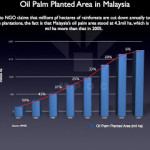The Amazing Oil Palm – A life-giving economic mainstay
There are old oils and new oils. There are oils that have been used for thousands of years, and some that have been used for less . than a hundred. Traces of some oils have been found in ancient Egyptian tombs dating back about 5,000 years ago. Some were designed in labs in the 1930s.
Palm oil, like olive oil, has been around for thousands of years. Like olive oil and avocado oil, it comes from the fruit of the tree rather than the seed; in this case Elaeis Guineensis Jacq., a species of oil palm tree that originates from West Africa. The oil palm trees flourish in heat and rain; not surprisingly, Malaysia is one of its biggest producers. generating about 34 per cent of global production.
All fruit-based oils share similar health benefits. Comparative studies of the benefits of olive oil and palm oil on humans show similar positive results on cholesterol levels. Other studies comparing the dry growing Conditions of the olive with the wet tropical conditions of the palm (which forced it to develop high levels of antioxidants to protect its fruit) show palm oil as offering even greater benefits to human health.
 Not only do these antioxidants protect human life, but they also provide a longer shelf life. Palm oil, the world’s most popular edible oil, can be found as an ingredient in nearly 50 per cent of the products sold in our supermarkets, including food, cleaning agents, cosmetics and toiletries. Palm oil is also gaining traction as a reliable source for biofuel.
Not only do these antioxidants protect human life, but they also provide a longer shelf life. Palm oil, the world’s most popular edible oil, can be found as an ingredient in nearly 50 per cent of the products sold in our supermarkets, including food, cleaning agents, cosmetics and toiletries. Palm oil is also gaining traction as a reliable source for biofuel.
Yet in recent yeas, the palm oil industry has taken a beating in the international press, where accusations of deforestation, unsustainable farming practices, and damage to native orangutan habitats have hampered what is one of Malaysia’s largest employers and economic mainstays the industry contributes 10 per cent or the country’s total export earnings. Oil palm plantations are essentially reforestation activities.
The cultivation of oil palm spread in the mid 70s and 80s as a result of the decline of the rubber industry in Malaysia Since then, “the country has come to view it as one of its main sectors for revenue generation. It is one of the 12 national key economic areas promoted under the Economic Transformation Programme,” says Dr Yusof Basiron, CEO of the Malaysian Palm Oil Council “and I believe it is ranked number two row, so it is very important in terms of priority for future development”.
Dr Basiron, who feels Malaysia’s oil palm industry has been unfairly singled out by critics, defends its excellent sustainability record. Oil palm produces more vegetable oil per hectare per year than any other crop and therefore requires the least area of Imd to produce the same tonnage of oil as produced by any competing oil crop. He argues that the global livestock industry has deforested 400 times more than the area that oil palm cultivation has, and that UN-FAO studies point to the commercial cultivation of crops like soybean as posing a much more significant deforestation threat. Oil World data also show that of the four major oil crops, soybean, sunflower, rapeseed and oil palm, soybean tops the list of land utilisation with a global planted area of 109.6 million ha.
Indeed, Malaysia has dedicated 50 per cent of its total land area to permanent forest conservation – a commitment made at the 1992 Rio Earth Summit which is still intact The oil palm occupies about 16 per cent of the country’s land area Malaysia’s oil palm industry has also established a fund for wildlife and biodiversity conservation, and Dr Basiron says that the orangutan population in East Malaysia is actually on the rise. Yet, in order to prove its sustainability, the industry has, in recent years, been forced to jump through certification hoops not demanded of o1hers in order to protect its valuable export industry. And although Malaysian farmers have now certified over 50 per cent of their production, it has been a costly endeavour given that standards are often a moving goal post.
In order to address the issue of this ”free-for-all introduction of standards,” the Malaysian Palm Oil Council has proposed a set of national standards that will place the industry back in the driver’s seat, and help convince the world what Dr Basiron says Malaysia has always known – that “the Malaysian palm oil industry was developed wi1h sustainability in mind right from the start, because we merited the industry and technology from the British planters, who started this business. They wanted it to be as sustainable as possible. We have never faced any sustainability issues. But. of course, the question is, how do we prove this?”
This article was published in The Time UK on December 29, 2014.










Leave a Reply